This post may contain affiliate links. Please read our disclosure policy.
Ready to eat your way through Kyoto? From iconic saba zushi and exquisite kaiseki to matcha desserts you’ll dream about later, here are the city’s must-try dishes and local favorites.

As Japan’s former imperial capital, Kyoto has a food culture that’s both sophisticated and endlessly diverse. Time-honored traditions meet modern creativity, and you’ll find something delicious around every corner, whether it’s in the bustling stalls of Nishiki Market or the lantern-lit streets of Gion.
In this guide, we’ll share 12 must-eat dishes in Kyoto and where to try them.
Nishin Soba (にしんにそば)

Nishin soba was originally created by the Hokkaido indigenous group, the Ainu, but was later brought to Kyoto by Kitamae ships and sold there. During times when transportation was difficult, herring was dried to preserve and extend its shelf life. The dried herring was then boiled in a broth, which slowly seeped into the fish, creating an intensely sweet and salty flavor.
The herring was originally served on top of udon noodles. Later, soba became the preferred choice due to its health benefits and ease of consumption. This shift led to the creation of nishin soba, a dish that has since flourished as one of Kyoto’s most beloved noodle dishes.
I tried my first-ever bowl of nishin soba while chasing the autumn leaves at Sanzen-in. It’s a simple dish but absolutely memorable.
Saba Zushi (鯖寿司)
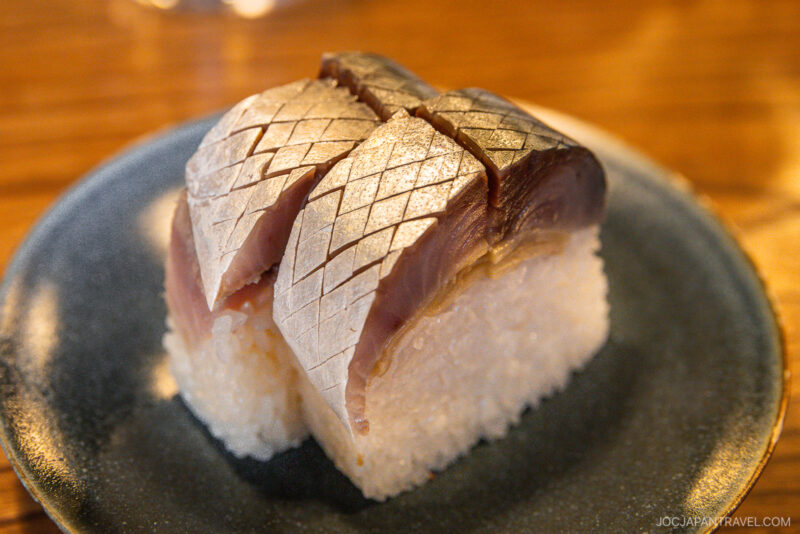
Saba zushi is a type of mackerel sushi that originated in Kyoto during the Edo period (1603–1868). Mackerel was caught in Wakasa Bay in Fukui, along the Sea of Japan, and transported to Kyoto, the former capital. The journey took nearly three days, during which the fish would spoil if left untreated. To preserve it, the mackerel was salted or grilled before transport. Once it reached Kyoto, it was paired with vinegared rice—giving birth to saba zushi.
The route between Wakasa Bay and Kyoto became so renowned it was nicknamed Saba Kaidō, or “Mackerel Road.” Today, Saba Kaidō is recognized as a Japan Heritage Site under the title “Wakasa’s Cultural Heritage of Travel Connecting the Sea and the Capital.”
Where to Eat Saba Zushi
A Kyoto friend recommended “/S/ KAWAHIGASHI” for tasting the famed saba zushi. Thanks to the salt curing, the mackerel had a wonderful texture—firm yet tender—and a subtle sweetness that balanced beautifully with the vinegared rice.
The restaurant itself is intimate, with just nine seats, and highlights authentic Japanese cuisine made with locally sourced ingredients. At lunchtime, you’ll find comforting bowls of udon, while dinner features smaller à la carte dishes alongside the specialty sushi.
Kinshidon (きんし丼)
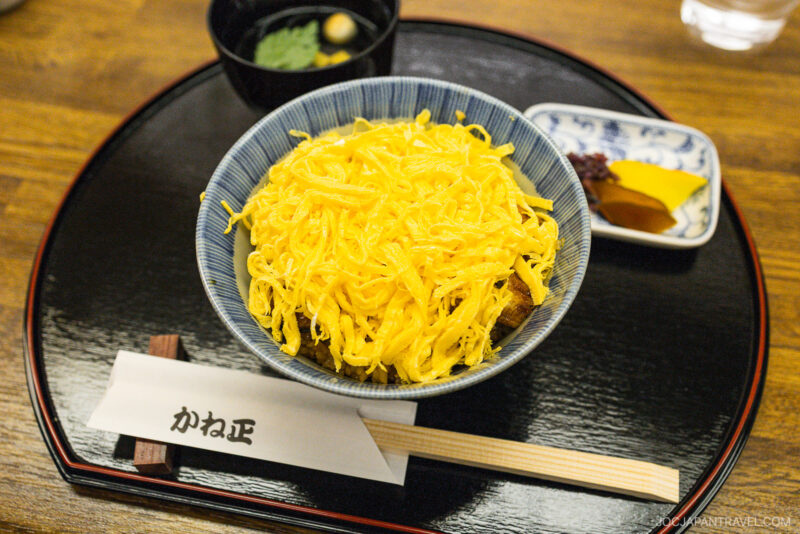
Anyone who enjoys unagi (eel) will instantly fall for kinshidon. Think of an unadon (grilled eel rice bowl) crowned with delicate ribbons of tamagoyaki-style egg. A newer twist places the shredded egg on top, creating a visually stunning bowl that’s just as easy to enjoy as it is to prepare.
Where to Eat Kinshidon
Kinshidon is said to have originated at Osakayama Kaneyo, just outside Kyoto on the west side. Along with Kyogoku Kaneyo, it’s considered one of the two most famous eel restaurants serving kinshidon in the area. But with that fame comes long lines and tricky reservations.
Don’t worry, there are other excellent spots, especially smaller shops scattered around the city. If you’re exploring the Gion area, check out Kanesho, a little restaurant tucked away in a back alley.
The shop is intimate, with counter seating that lets you watch the chef expertly grill the eel. Prepared Kansai-style—slit down the belly and grilled without steaming—the eel develops a crispier texture. By the time it reaches your table, it’s gone in minutes because kinshidon is just that irresistible.
Kaiseki Cuisine (懐石料理)
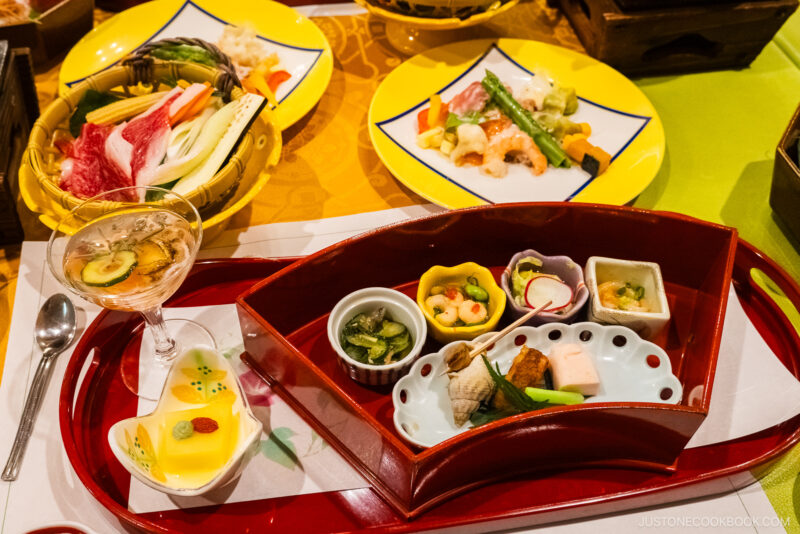
Kyoto is the birthplace of Kaiseki cuisine, a multi-course meal that epitomizes fine dining in Japan. You can find Kaiseki being served in dedicated restaurants, but the best way to enjoy it is at a ryokan (a traditional Japanese inn).
After a relaxing soak in the ryokan’s onsen, you can savor the luxurious Kaiseki course meal in the dining room or in the comfort of your own room. For an authentic Japanese experience, a stay at a ryokan with a Kaiseki meal is an absolute must.
Obanzai (おばんざい)
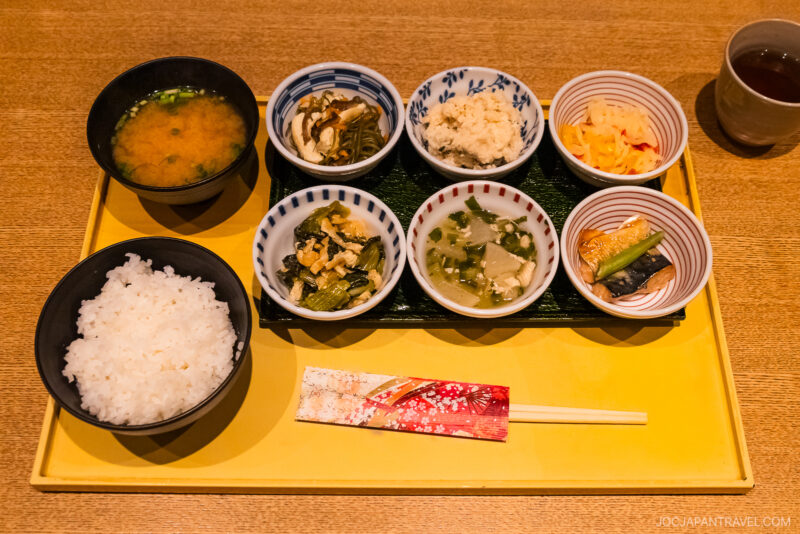
While Kyoto is known for some of Japan’s most luxurious cuisine, don’t miss out on the city’s rustic, homely cooking called Obanzai. This traditional style, native to Kyoto, highlights local and seasonal ingredients and recipes passed down through generations.
Each dish uses simple seasonings to allow the natural flavors to shine through. Typically, vegetables and seafood are used, incorporating parts that would otherwise be discarded.
I stayed near Kyosami Nomura, a specialized Obanzai restaurant that opens early in the morning. For just 850 yen, you can enjoy the “Obanzai Set”, which includes six small dishes of your choice, along with rice and miso soup.
Yuba (ゆば)
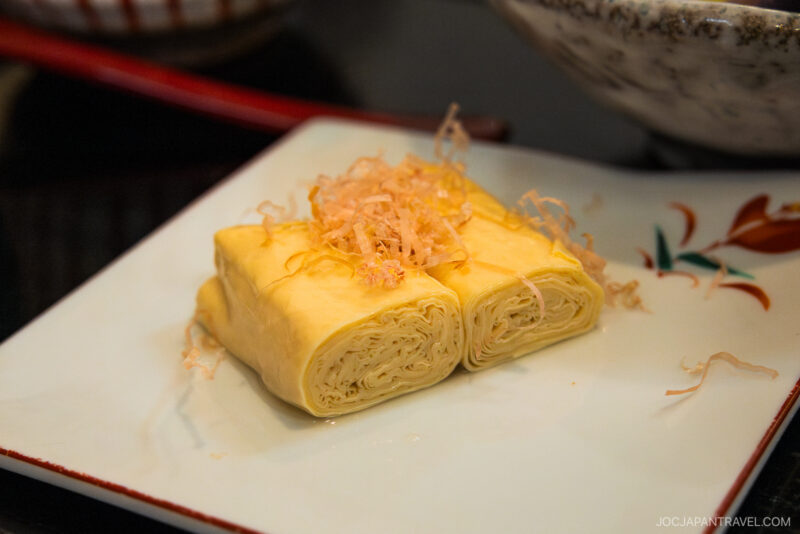
Continuing with delicious and healthy foods, yuba (tofu skin) is next on our list.
Yuba is made from the thin layer that forms on heated soy milk and is prized for its silky texture and subtle flavor.
It’s believed that Chinese Zen monks introduced yuba to Kyoto over 1,200 years ago. This humble ingredient not only became a staple in local households but also served as an important protein source for Buddhist monks following strict vegetarian diets.
Where to Eat Yuba
You can find yuba in restaurants all over Kyoto. Some focus entirely on it, while others offer it as an addition to their menu.
Near Kiyomizu-dera, the iconic temple tucked into the wooded hills east of the city, I loved visiting Yubasen, a restaurant that specializes in yuba dishes. Their set menu lets you taste yuba in six different ways. It’s such a treat to sample the variety, and I can’t recommend these specialty restaurants enough for anyone curious about this delicate Kyoto classic!
Gyukatsu (牛カツ)

Gyukatsu has taken Japan by storm since the mid-2010s. While tonkatsu (deep-fried pork cutlet) was long the favorite, especially in Tokyo, the beef-loving culture of Kansai gave rise to gyukatsu.
When in Kyoto, consider visiting Kyoto Katsugyu, the country’s largest gyukatsu chain, where you can choose from a variety of beef cuts. The preferred cut is breadcrumbed and deep-fried so it’s crispy on the outside and rare inside. At the table, each slice can be cooked to your liking on a mini candle-lit hot plate.
The meal comes with shredded cabbage, rice, soup, and a selection of dipping sauces, perfect for enjoying every bite of the tender beef.
Kyoto Ramen (京都ラーメン)

Although Kyoto doesn’t have a signature ramen style like tonkotsu in Hakata or miso in Sapporo, it’s known for its rich broths made from pork or chicken bones, usually flavored with soy sauce. In recent years, the city’s growing ramen scene has introduced variations of Kyoto Ramen, some incorporating shellfish, dried sardines, and even bone powder.
My recommendation for the best bowl: Inoichi Ramen
Craving a bowl? Head to downtown Kyoto and visit Inoichi. It might be hard to justify lining up for ramen, but this spot is worth it. They take classic soy sauce–flavored ramen and elevate it to a whole new level.

The dashi-based broth at Inoichi is the star, made with kelp and dried fish like sardines and bonito, flavored with either white or black soy sauce. I went with black soy sauce for a bolder punch, and even without meat, it’s rich, balanced, and deeply satisfying.
Toppings like kelp, yuzu zest, and kuro-shichimi (black seven-spice pepper) let you customize every bite.
Don’t miss the rice with freshly shaved bonito flakes and a raw egg yolk. The umami-packed flavor and delicate texture are unmatched.
Yes, the line can be long, but Inoichi is absolutely worth the wait.
Matcha Desserts
Kyoto is Japan’s matcha capital. In Uji and Yamashiro, green tea varieties like gyokuro, matcha, and sencha have been perfected for over 800 years. Today, you can enjoy these rich, earthy flavors in sweets—from creamy cakes to delicate wagashi—making every bite a taste of Kyoto’s tea tradition.
Matcha Animitsu & Wagashi (あんみつ&和菓子)

What better way to enjoy matcha than visiting Uji itself? Check out our complete guide on what to do in Uji!
After exploring Uji’s rich history and stunning tea fields, stop by Fukujuen Uji to try matcha anmitsu—small cubes of agar jelly (kanten) with red bean paste, mochi, fruits, beans, and matcha ice cream. Pour the sweet matcha sauce on top for an extra layer of earthy sweetness.
Another must-do is a traditional tea ceremony at Tiahoan. Watch the kimono-clad staff prepare the perfect bowl of matcha with elegance and precision. You can even try making matcha yourself the traditional way!
Matcha Parfait (抹茶パフェ)

There’s nothing more luxurious than a giant parfait at Gion Tsujiri, one of Kyoto’s most prestigious tea shops. After browsing the first-floor tea selection, head upstairs to Saryo Tsujiri for a range of tea-flavored desserts and savory dishes.
The café’s parfaits are the star attraction. The tsujiri parfait is a matcha treasure trove with jelly, ice cream, and chestnuts. Cake lovers will enjoy the matcha castella parfait or the hojicha (roasted green tea) parfait, with its nutty, almost chocolate-like flavor. Whichever you choose, it’s a treat!
Matcha Zenzai (抹茶ぜんざい)

Another classic dessert is zenzai, a sweet soup of azuki beans served with mochi or shiratama dango. In Kyoto, you can enjoy it with a matcha twist.
When visiting Kifune Shrine, take the picturesque walk lined with ryokans, cafés, and restaurants. At Kifune Club, try their matcha zenzai topped with toasted mochi. The sweet soup has a subtle earthy bitterness from the matcha, balanced by a small serving of salted kombu strips. It makes a lovely pit stop on your shrine trek.
Warabi Mochi (わらびもち)

Warabi mochi is made from bracken starch, giving it a light, jelly-like texture that’s more refreshing than traditional glutinous rice mochi.
In Gion, Gion Tokuya serves some of Kyoto’s finest sweets, including hon warabi mochi made with domestically produced bracken starch and refined Japanese sugar. The kinako adds a nutty sweetness, while kuromitsu gives a delicate molasses flavor—utterly addictive.
They also offer anmitsu, zenzai, and other desserts. It’s worth the wait, though lines can sometimes exceed an hour!
Tarte Tatin (タルトタタン)

Tarte tatin may not be a quintessential Kyoto dish, but La Voiture is worth a visit. Originally a French restaurant, it became a specialty café for apple tarte tatin in 1981. Owners Yuri Matsunaga and her husband fell in love with the dessert in France and decided to recreate it in Japan, serving just two tarts a day.
The cozy kissaten (tea room) is inviting, and the tarte tatin is exquisite. Fuji apples are boiled for five hours, developing a deep caramelized color and a sweet-savory flavor, perfectly balanced with a side of yogurt sauce and a freshly brewed cup of coffee. I still remember taking my first bite—warm, tender, and unforgettable.
Savoring Kyoto: Share Your Favorites
Any visitor to Kyoto will find the city brimming with unforgettable experiences and remarkable food at every turn. Each dish reveals a piece of Kyoto’s rich cultural tapestry, inviting you to savor not just the flavors but the very essence of this historic city.
What are some of your favorite food experiences in Kyoto? Do you have recommendations we didn’t cover above? Share them with us in the comments!




